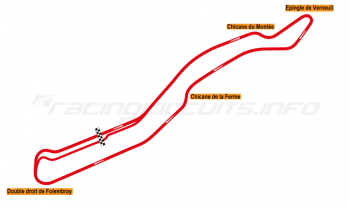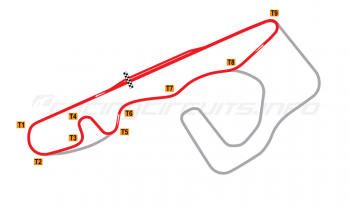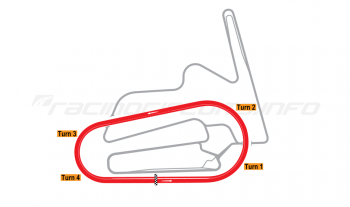Grenzlandring
Circuit Overview
Race tracks occasionally spring up as if from nowhere, either on airfield perimeter roads, flat-out blasts in the open countryside or around twisty city streets. But uniquely, the Grenzlandring (literally border-region ring) emerged in post-war Germany using infrastructure once constructed in secret to become one of the fastest circuits in the whole of Europe.
Hermann Lang once described Grenzlandring as "the longest flat race track in the world" but its speed was to be short-lived.
In 1952, Helmut Niedermayer crashed at Roermonder Kurve, his car careering into the crowd, killing 13 and injuring over 40 people in truly horrific scenes. The authorities were quick to act and racing was banned at the Grenzlandring thereafter and today it looks like any other bypass road.
Circuit History
At the beginning of the WWII (June 1939), German soldiers needed a route to transport men and machinery to the 'Siegfried Line' (known in German as the Westwall), the fortified defensive line built along German/Dutch border. The public road from Erkelenz via Beeck, Dorp, Wegberg to Roermond was too small, so construction began on a new road, at the cost of 3.3 million Reichsmark. Heavy army vehicles travelling over it meant that, unusually, concrete was used for the entire 9km length and some 434,300 hours of labour between June 1940 and June 1942 was required to finish the project.
What resulted was a northern and southern bypass encircling the two towns and stretching for more than 5 miles of long straights and sweeping curves to form an egg-shaped ring. The intention was to use the road to supply strategic construction sites at the border but in reality it was seldom used and had largely fallen into disuse by the end of the war as the German position deteriorated.
An oft-repeated story puts the subsequent discovery of the road's potential for racing with the mayor of the nearby town of Rheydt, Dr. Carl Marcus. Purportedly, on a dark night in 1947, Marcus was driving on a stretch of the circuit when he passed the same cyclist twice and it became apparent that the 'secret' road must be a perfect oval. He soon shared his idea with Emil "Teddy" Vorster, a silk weaving mill owner and keen racing driver who was a prime mover in the Rheydter Club für Motorsport (RCM). Not long after planning would begin for racing around the concrete loop.
It's a nice story, but conveniently overlooks some key facts; the road was not by this time especially secret, neither to the Allies or more especially to locals, nor was it in fact driveable all the way round at this time. At the end of the war, American troops were using the Rheydter straights as gasoline depot, while the Erkelenzer straight was used by the British as a workshop for military vehicles. Add in Herr Marcus' somewhat shady past as a British spy and doubts about the authenticity of much of his personal story and it soon becomes clear that this story was little more than marketing hype, circulated to generate interest in the first events.
What is true, however, is that Vorster took the idea for racing to the German Motor Club (DMC) in Cologne in March 1948, after which a delegation was dispatched to assess its suitability. Among the luminaries present were Hermann Lang and Alfred Neubauer and the verdict was unanimous: the Grenzlandring was go, with a statement to the media proclaiming it as the "AVUS of the west".
Racing begins and speed records tumble
The first race took place on September 19, 1948, organised jointly by the RCM and the Erkelenzer Motorsportclub, after repairs had taken place to repair wartime damage. Temporary wooden tribunes were erected and the marketing programme clearly worked, with around 250,000 spectators turning out to see the action.
Formula 2 racing topped the bill each season, with the first victory in 1948 going to Roland Mall in a self-made BMW-powered special. Motorbikes also featured on the race card, with Georg "Schorsch" Meier winning the 500cc race. Immediately the Grenzlandring gained a reputation as one of the fastest circuits in Europe, a fact which was proved when Meier set fastest lap on his supercharged 500cc BMW motorbike, at an incredible 196.8 km/h...
This high speed did cause competitors a few problems, however. Bill Paterson was astounded when he arrived with his Cooper JAP. "We looked at the works cars of Brandon and Brown and they had huge sprockets on the crankshafts of their Norton engines," he said. "We didn't have anything like that, so we rang JAP and got them to send the biggest ones they had..."
With no banking and only a 6.8 metre width, the circuit was fast and dangerous, with little room for error. It was used anti-clockwise in all seasons except for 1949, when an experimental running in the reverse direction proved short-lived.
Tragedy sparks the end
Perhaps unsurprisingly, the Grenzlandring proved popular with spectators, but it was destined to have only a short competition life. Racing was brought to an abrupt end on in August 1952 when Helmut Niedermayer, a race driver from Berlin, came off the road at the Roermonder Kurve. He careered into a crowd of people, killing 13 and injuring over 40 people in truly horrific scenes.
The races actually continued on regardless, supposedly to prevent panic among the crowds and allow rescue operations to take place unhindered, though contemporary reports suggest a more plausible explanation lay with a combination of incompetence and indifference to the true scale of the disaster.
It didn't take authorities long to react, however, and the Interior Minister for the Nord Rhine-Westphalia region closed the Grenzlandring for all other racing activities a short time later.
Today the concrete is long gone, replaced by asphalt and the track is in use as local roads surrounding the city of Wegberg and, bar a few minor alterations for roundabouts, race fans can still make a pilgrimage to the site and drive around the old circuit - although well within the speed limits!
In 1999, to celebrate the 50th anniversary of the start of racing, a celebration run was held over part of the course for vintage racing cars, then in 2012 a commemoration stone was laid at Roermonder Kurve to mark the 60th anniversary of the tragic accident which brought racing on the Grenzlandring to a close.
Jump onboard
Circuit info
This is a historic circuit which is no longer in operation.
Rate This Circuit
Votes: 1159
Location Information
The Grenzlandring is located at the edge of the towns of Wegberg and Beeck in Nord Rhine-Westphalia, Germany. The nearest airport is Düsseldorf International Airport, around 30 minutes' drive away.
Today there is little to show that this was the site of one of the fastest circuits in Europe, with the track simply absorbed into the local road network. It has been diverted at several points, including at the exit of the Roermonder Kurve, where it now peels to the right to form a right-angled junction with the road towards Klinkum. At this junction you can find the memorial stone which was erected in 2012.
Get your race tickets!
Brought to you with: 
We've teamed up with Motorsports Tickets to bring you the best deals for Formula One, MotoGP, Le Mans and more.










